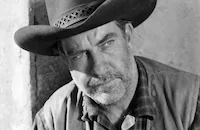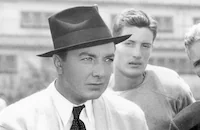No Time for Love

Brief Synopsis
Cast & Crew
Mitchell Leisen
Claudette Colbert
Fred Macmurray
Ilka Chase
Richard Haydn
Paul Mcgrath
Film Details
Technical Specs

Synopsis
Renowned New York photographer Katherine Grant feuds with the managing editor of Mirror magazine over the content of her photographs, which tend to be more artistic than commercial. When she is assigned to photograph the Interborough Vehicular River Tunnel project, she dons a hardhat and boots and goes deep underground. The superstitious tunnel workers, called "sandhogs," fear that a woman in the tunnel will bring bad luck. Katherine's distracting presence causes a nearly fatal accident for Jim Ryan, a self-assured, brawny sandhog nicknamed "Superman," who is almost crushed by a machine because Katherine insists on taking his picture. Katherine drags an unconscious Jim out of harm's way, but their work disrupted, the sandhogs are dismissed for the day. When he revives, Jim feels disgraced that a woman saved his life, and while in the compression chamber, he gets embroiled in a fistfight with his taunting co-workers and is photographed by Katherine. Jim later accuses Katherine of flirting with him, and although he is right, she coldly tells him that her boudoir chair has more integrity than he does. Katherine develops the photographs and shows them to her sister Hoppy, calling Jim an "ape." She also shows the pictures to her snobby sophisticated friends, including Mirror publisher Henry Fulton, her suitor, playwright Dunbar, and Roger, a composer, who are delighted by her foray into the blue-collar world. Jim, piqued by Katherine's previous insult, returns her tripod to her at her apartment, and regains his confidence after he kisses her and then dismisses her. When Katherine's friends eagerly ask him to describe his fistfight, Jim demonstrates and knocks out Henry. For weeks afterward, Katherine finds herself plagued by dreams in which Jim appears as a "superman" and rescues her from an evil suitor. Jim is suspended from work after Henry publishes Katherine's pictures of the fistfight, which he stole from Katherine. After assuring Jim that she had nothing to do with the publication of the photo, Katherine hires Jim to be her assistant, hoping to prove to herself that he is not worthy of her love. Instead, Katherine falls in love with Jim, but he dumps her when he finds out from Hoppy about Katherine's true intentions. Sometime later, a cave-in interrupts the tunnel project, and Jim, an engineer by training who was working as a sandhog only to better understand the project, conceives of a plan to save the tunnel. Katherine is assigned to report on the trial run of Jim's newly invented machine, and returns to the tunnel along with a host of other reporters. Katherine resents being kept a safe distance from the work with the other reporters, and sneaks further into the tunnel, where Jim and his assistants make a trial run with the machine. While Katherine photographs the machine at work, a breach in the wall results in a mudslide, and she is buried underneath. The sandhogs abandon the machine to save her, and Jim's test run is declared a failure. Katherine convinces Roger, and Jim's friend Clancy to return to the muddy tunnel to find her camera, because her pictures will prove that the machine was actually working. They successfully retrieve the camera from the thigh-deep mud, and as a result of the photographs, the city reinstates Jim and reopens the tunnel project. Katherine insists that Jim never know she was responsible for his reinstatement, and becomes engaged to Fulton. Roger tells Jim the truth, however, and warns him that she is marrying Fulton even though she still loves Jim. That night, Darlene, a showgirl that Jim has been dating, interrupts Katherine's engagement party to warn her to stay away from Jim, and when she slaps Katherine, Katherine punches back. Jim arrives in time to witness Katherine's spunk and asks her to choose between him and Fulton. When she chooses Jim, he proudly carries her out over his shoulders.

Director

Mitchell Leisen
Cast

Claudette Colbert

Fred Macmurray

Ilka Chase

Richard Haydn
Paul Mcgrath

June Havoc

Marjorie Gateson

Bill Goodwin
Robert Herrick
Morton Lowry

Rhys Williams
Murray Alper
John Kelly
Jerome De Nuccio

Grant Withers
Rod Cameron
Willard Robertson
Arthur Loft

Fred Kohler Jr.

Tom Neal
Max Laur
Oscar G. Hendrian
Tex Harris
Ted E. Jacques
Art Foster
Sammy Stein
Jack Roper

Woodrow W. Strode
Frank Moran

Alan Hale Jr.
Dave Wengren
Bob Homans
Walter Soderling
Mickey Simpson
Lorin Raker
Faith Brook
Frederic Henry
Paul Phillips
Mitchell Ingraham
Ben Taggart
Pat Mcveigh
Jack Shay
Lillian Randolph
Keith Richards
Kenneth Chryst
Jack Gardner

Charles Irwin
Ronnie Rondell
George Dolenz
Jack Roberts
Pat West
Crew
Chico Alonso
Opal Baker
Gladys Baxter
G. Belassario
Claude Binyon
Clayton Brackett
Richard Brandow
Eleanor Broder
Harry Caplan
C. C. Coleman
Sam Comer
B. G. Desylva
Jack Donohue
Hans Dreier
Warren Duff
Farciot Edouart
David Ettenson
Ed Frazier
Fred Graham
Earl Hayman
Edith Head
Peggy Higgins
G. Hirsch
Irene
Gordon Jennings
Don Johnson
La Prele Jones
Wallace Kelley
Fred Kohlmar
Charles Lang Jr.
Sam Ledner
Robert Lees
Mitchell Leisen
Curly Linden
Alma Macrorie
Al Mann
Ray Moyer
Hazel Noe
Harold Nye
Elaine Ramsey
Fred Rinaldo
Leonora Sabine
Edward Sanell
Harold Schwartz
Robert Usher
J. Vincent
Hal Walker
Charles Wall
Wally Westmore
Mary Wiggins
Victor Young

Videos
Movie Clip


Film Details
Technical Specs

Award Nominations
Best Art Direction
Articles
No Time For Love
> Both Colbert and MacMurray had worked frequently with director Mitchell Leisen -- MacMurray would make a total of nine films with him, and Colbert four (she had also worked with Leisen during his days as costume designer, notably in Cecil B. DeMille's 1932 epic, The Sign of the Cross). Leisen told his biographer that No Time for Love was a happy collaboration. "Fred and Claudette worked so wonderfully together. Many times when I was setting up the next scene, they'd go off in a corner and work it up themselves. They'd show me how they wanted to do it and it would be just right." Because of wartime restrictions on film stock, they rehearsed extensively before shooting, and Leisen usually printed the first take.
The tunnel was built on Paramount's largest stage. It was 25 feet long, and in the climactic scene, filled with mud. According to Leisen, set designers tried all sorts of combinations of material to avoid using real mud, but nothing looked right except the real thing. In the end, they used adobe and water, keeping a cement mixer going on the stage to get the right consistency. "I never asked the actors to do anything I wouldn't do," Leisen recalled, "so on our first day in the tunnel, I dove right into the mud, head first. I came up and said, 'All right, let's go.'" Colbert got the worst of it, in one scene struggling through mud up to her neck. After the first take, Leisen noticed she didn't have any mud on her face. "I said, 'Come here, honey,' and took a handful of the mud and slapped it on her face. She went right back in and did it again."
Wartime austerity measures limited the amount of money that could be spent on construction materials. Staying within those limits required considerable ingenuity, but Leisen, a former art director, was up to the task. The sets for Colbert's previous film, The Palm Beach Story (1942), which had been built with her preferred camera angle in mind, were still standing. With paint and Victorian furniture from the prop department, one of those sets was turned into Colbert's boudoir in No Time for Love. A Dali-esque dream sequence with MacMurray as Superman saving Colbert from the clutches of a villain required a minimal set and might have been Leisen's warm-up for the more elaborate dream sequences in his next film, Lady in the Dark (1944). No Time for Love was nominated for an Academy Award for Best Art Direction, but lost to Gaslight (1944).
No Time for Love proved to be a pleasant diversion for war-weary audiences. After praising the film and performances, Bosley Crowther wrote in the New York Times, "Of course, one might argue that this picture is too frivolous for this day and time. But we'd call it a first-class example of the inconsequential put to highly diverting use."
The following year, the Colbert-McMurray-Leisen team reunited for another romantic comedy, Practically Yours (1944). According to Leisen, MacMurray told Colbert, "The trouble with this picture is that we're both too damned old for it." Even though it was one of the year's top grossing films, he was probably right. It was Colbert's final film under contract to Paramount. That same year, she took on her first role as the mother of teenagers, in Since You Went Away (1944). MacMurray segued brilliantly into film noir in Double Indemnity (1944). In their last two films together, The Egg and I (1947) and Family Honeymoon (1949), Colbert and MacMurray would no longer play boy-meets-girl, but husband and wife.
Director: Mitchell Leisen
Producer: Fred Kohlmar, Mitchell Leisen
Screenplay: Claude Binyon, adapted by Warren Duff from a story by Robert Lees and Frederic I. Rinaldo
Cinematography: Charles Lang, Jr.
Editor: Alma Macrorie
Costume Design: Edith Head, Irene
Art Direction: Hans Dreier, Robert Usher
Music: Victor Young
Principal Cast: Claudette Colbert (Katherine Grant), Fred MacMurray (Jim Ryan), Ilka Chase (Hoppy Grant), Richard Haydn (Roger), Paul McGrath (Henry Fulton), June Havoc (Darlene), Marjorie Gateson (Sophie), Bill Goodwin (Christley), Robert Herrick (Kent), Rhys Williams (Clancy).
BW-83m.
by Margarita Landazuri

No Time For Love
Quotes
Oh, you---you coward! Kissing a woman!- Katherine Grant
What am I supposed to kiss?- Jim Ryan
Aw, gee, you're wonderful!- Darlene
Just keep that in mind.- Jim Ryan
If I get mad, I'm liable to throw ya a dirty look. And where I look dirty, no grass grows. Ever.- Darlene
Doorbells should ring once and then electrocute the ringer.- Hoppy Grant
Trivia
Notes
Hollywood Reporter news items and the Paramount Collection at the AMPAS Library provide the following information about the production: Oscar Levant was originally cast in this film, but withdrew because shooting was postponed and he had conflicting commitments. Rita Hayworth was also initially cast in this film. After Levant's departure, production was delayed by a year and a half. Technical advisors Charles Wall and Edward Sanell worked for the New York Tunnel Authority. Paramount production notes indicate that the New York Tunnel Authority allowed Paramount to use the blueprints for the subway tunnel running from Brooklyn to the Battery. This film was nominated for an Academy Award in the category of Best Art Direction/Interior Decoration (black & white), Hans Dreier, Robert Usher/Sam Comer.














